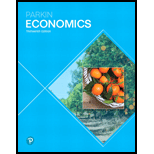
Macroeconomics
13th Edition
ISBN: 9780134735696
Author: PARKIN, Michael
Publisher: Pearson,
expand_more
expand_more
format_list_bulleted
Question
Chapter 1.A, Problem 4RQ
To determine
The graphical illustration of positive relationship between the two variables.
Expert Solution & Answer
Want to see the full answer?
Check out a sample textbook solution
Students have asked these similar questions
Sam's profit is maximized when he produces
shirts. When he does this, the marginal cost of the last shirt he produces is
, which is than the price Sam receives for each shirt he sells. The marginal cost of producing an additional shirt (that is, one more shirt than would maximize his profit) is
, which is than the price Sam receives for each shirt he sells. Therefore, Sam's profit-maximizing quantity corresponds to the intersection of the curves. Because Sam is a price taker, this last condition can also be written as .
Why must total spending be equal to total income in an economy?
Total income plus total spending equals total output.
The value-added measurement of GDP shows this is true.
Every dollar that someone spends is a dollar of income for someone else.
all of the above
Labor Market Data
Price
$5
$10
$15
$20
$25
3,000,000 6,000,000 9,000,000 12,000,000 15,000,000
Qd 15,000,000 12,000,000 9,000,000 6,000,000 3,000,000
Price
$30
$25
$20
$15
$10
$5
+
+-
x-
3 6
Do
+
+
F
9 12 15
Quantity (In millions)
Area of a triangle = 1/2* base *height
Market Efficiency & Total Surplus
Worth Publishers
SCENARIO:
The state government is considering raising the minimum
wage from $15 per hour to $20 per hour over the next 3
years. As an economic advisor to the governor, you have been
asked to provide a recommendation on whether the minimum
wage should be increased based on economic theory.
Consider the labor market data provided.
Prepare a brief report that:
1. Explains whether the labor market is currently efficient at the
equilibrium wage of $15 per hour. How would you know? At
equilibrium, what (dollar amount) is the Total Surplus this market
provides? Show your rationale with numbers.
2. Analyzes the impact on total surplus in the market if the
minimum wage is raised…
Chapter 1 Solutions
Macroeconomics
Ch. 1.1 - Prob. 1RQCh. 1.1 - Prob. 2RQCh. 1.1 - Prob. 3RQCh. 1.2 - Prob. 1RQCh. 1.2 - Prob. 2RQCh. 1.3 - Prob. 1RQCh. 1.3 - Prob. 2RQCh. 1.3 - Prob. 3RQCh. 1.3 - Prob. 4RQCh. 1.3 - Prob. 5RQ
Ch. 1.4 - Prob. 1RQCh. 1.4 - Prob. 2RQCh. 1.4 - Prob. 3RQCh. 1.4 - Prob. 4RQCh. 1.5 - Prob. 1RQCh. 1.5 - Prob. 2RQCh. 1.5 - Prob. 3RQCh. 1.A - Prob. 1RQCh. 1.A - Prob. 2RQCh. 1.A - Prob. 3RQCh. 1.A - Prob. 4RQCh. 1.A - Prob. 5RQCh. 1.A - Prob. 6RQCh. 1.A - Prob. 7RQCh. 1.A - Prob. 8RQCh. 1.A - Prob. 9RQCh. 1.A - Prob. 10RQCh. 1.A - Prob. 11RQCh. 1.A - Prob. 1SPACh. 1.A - Prob. 2SPACh. 1.A - Prob. 3SPACh. 1.A - Prob. 4SPACh. 1.A - Prob. 5SPACh. 1.A - Prob. 6SPACh. 1.A - Prob. 7SPACh. 1.A - Prob. 8SPACh. 1.A - Prob. 9SPACh. 1.A - Prob. 10SPACh. 1.A - Prob. 11SPACh. 1.A - Prob. 12APACh. 1.A - Prob. 13APACh. 1.A - Prob. 14APACh. 1.A - Prob. 15APACh. 1.A - Prob. 16APACh. 1.A - Prob. 17APACh. 1.A - Prob. 18APACh. 1.A - Prob. 19APACh. 1.A - Prob. 20APACh. 1.A - Prob. 21APACh. 1.A - Prob. 22APACh. 1.A - Prob. 23APACh. 1 - Prob. 1SPACh. 1 - Prob. 2SPACh. 1 - Explain how the following news headlines concern...Ch. 1 - Prob. 4SPACh. 1 - Prob. 5SPACh. 1 - Prob. 6SPACh. 1 - Prob. 7APACh. 1 - Prob. 8APACh. 1 - Prob. 9APACh. 1 - Prob. 10APACh. 1 - Prob. 11APACh. 1 - Prob. 12APACh. 1 - Prob. 13APA
Knowledge Booster
Similar questions
- Draw the IS-LM diagram at equilibrium and use it to show how one or both of the curves change based on the following exogenous changes. An increase in taxes. An increase in the money supply An increase in government purchasesarrow_forwardDon't use Ai. Answer in step by step with explanation.arrow_forwardcorospond to this message. Gross Domestic Product (GDP) represents the total value of all goods and services produced by a country. The news reporter shows excitement because rising GDP signifies positive economic performance. Consumer spending has increased while businesses expand and new job opportunities become available. If the GDP rises, your delivery business will likely handle more packages as consumer purchasing increases. The increase in business activity will lead to more opportunities for your company to generate higher profits. You may need to take action by hiring additional staff and purchasing extra delivery vehicles or finding ways to improve your operation speed and efficiency to meet increased demand.arrow_forward
arrow_back_ios
SEE MORE QUESTIONS
arrow_forward_ios
Recommended textbooks for you
 Economics (MindTap Course List)EconomicsISBN:9781337617383Author:Roger A. ArnoldPublisher:Cengage Learning
Economics (MindTap Course List)EconomicsISBN:9781337617383Author:Roger A. ArnoldPublisher:Cengage Learning

 Macroeconomics: Principles and Policy (MindTap Co...EconomicsISBN:9781305280601Author:William J. Baumol, Alan S. BlinderPublisher:Cengage Learning
Macroeconomics: Principles and Policy (MindTap Co...EconomicsISBN:9781305280601Author:William J. Baumol, Alan S. BlinderPublisher:Cengage Learning Microeconomics: Principles & PolicyEconomicsISBN:9781337794992Author:William J. Baumol, Alan S. Blinder, John L. SolowPublisher:Cengage Learning
Microeconomics: Principles & PolicyEconomicsISBN:9781337794992Author:William J. Baumol, Alan S. Blinder, John L. SolowPublisher:Cengage Learning

Economics (MindTap Course List)
Economics
ISBN:9781337617383
Author:Roger A. Arnold
Publisher:Cengage Learning



Macroeconomics: Principles and Policy (MindTap Co...
Economics
ISBN:9781305280601
Author:William J. Baumol, Alan S. Blinder
Publisher:Cengage Learning

Microeconomics: Principles & Policy
Economics
ISBN:9781337794992
Author:William J. Baumol, Alan S. Blinder, John L. Solow
Publisher:Cengage Learning
